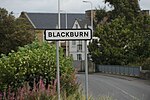HM Prison Addiewell
2008 establishments in ScotlandBuildings and structures in West LothianGovernment agencies established in 2008Prison stubsPrisons in Scotland ... and 4 more
Private prisons in the United KingdomScotland government stubsScots law stubsSodexo Justice Services

HMP Addiewell is a prison located near to the village of Addiewell in West Lothian, Scotland. HMP Addiewell is operated by a private company, Sodexo Justice Services and contracted to the Scottish Prison Service. The prison holds adult males who have been convicted as well as those being held on remand.
Excerpt from the Wikipedia article HM Prison Addiewell (License: CC BY-SA 3.0, Authors, Images).HM Prison Addiewell
Blackburn Road,
Geographical coordinates (GPS) Address External links Nearby Places Show on map
Geographical coordinates (GPS)
| Latitude | Longitude |
|---|---|
| N 55.8468 ° | E -3.5993 ° |
Address
HM Addiewell Prison
Blackburn Road
EH55 8NG
Scotland, United Kingdom
Open on Google Maps










